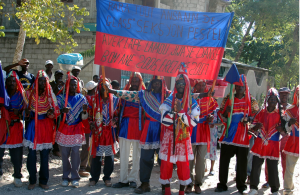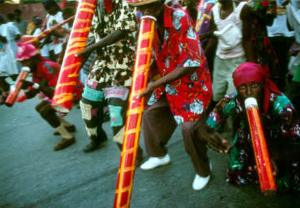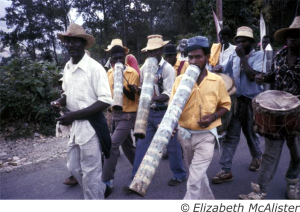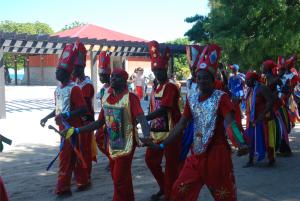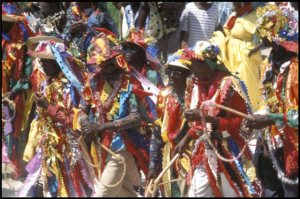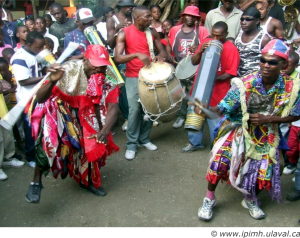This post is also available in: Kreyol
An in depth look at the structure, history and rituals of Rara in Haiti by Taino L & Ayiti Bèl.
There is much confusion when it comes to retracing the history of Rara. According to some, such as Harold Courlander, Moreau de St. Rémy and Jean-Baptiste Roumain, Rara traces back to Africa and was adopted in Haiti through slavery. However, according to others, Rara is a colonial heritage, given to the colonies as a recreational day. Jean Coulanges says Rara “comes from the times of the indigenous peoples of the Americas, where the Mayans had a day of pleasure dedicated to nature.”
The word “Rara” comes from the Yoruba language (meaning, “loud” or “a lot of noise”). We have known rara from the beginning of colonial times. It calls upon the principles of the religious African kingdom of Congo which prospered during the 14th and 15th centuries. It wields specifically the spiritual power of “Petwo” (the aggressive side of Vodou) and “Bizango” (the secret societies). However, well before Christopher Columbus arrived and killed 250,000 Tainos that were living on the island, the indigenous people of the island held festivals that strongly resemble what we celebrate as rara today.
In its early days, Rara bands did not use instruments, the members sang a capella. They used their hands and stones to create sounds. This is where Rara bands got the name “Chay O Pye”
Instruments were slowly added to the tradition as follows:
Local traditional instruments including:
- banbou and vaksen of various sizes which were traditionally made out of bamboo, but can be found today in copper, zinc and metal.
- Percussion: tanbou (haitian drum), bongos, graj (like a grater) and kwachi.
Modern instruments:
- Wind : bass, baritone, helicons , trombones, trumpets
- Percussion : Snare, bells, cymbals
A typical Rara band consists of three drummers, followed by banbou or vaksin. They are followed by other horn and percussion players, various hand instruments, and the chorus singers of the band. There is usually a group led by the Major Jon on the side, where the king and queen of the band are dancing and passing around a hat.
The tanbou of a Rara are made of goatskin, and are light in weight so the drummer can easily play while walking several kilometers, and have ropes woven all along the body of the drums. The banbou and vaksin are the instruments most associated with Rara. They are hollow tubes played as horn instruments. Each banbou has a different diameter to give a range of high and low sounds. Through the words sung, Rara bands create songs with messages that are usually sexual, political, or that speak of the situation of the country in general.
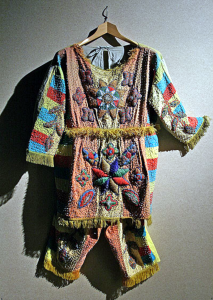 The founder of the band is the owner, and ensures the continuity of the band year after year by choosing a qualified member of the family to replace him/her once their reign has ended. A Rara band is modeled after a government: president, minister, mayor, colonel who walks around with a whip in hand etc. There is a hierarchy of authority that assures that there is proper distribution of power and division of labor. There are people there for all sorts of tasks: people there to make sure everything is in order, the band members, flag bearers, banner carriers, lamp carriers etc.
The founder of the band is the owner, and ensures the continuity of the band year after year by choosing a qualified member of the family to replace him/her once their reign has ended. A Rara band is modeled after a government: president, minister, mayor, colonel who walks around with a whip in hand etc. There is a hierarchy of authority that assures that there is proper distribution of power and division of labor. There are people there for all sorts of tasks: people there to make sure everything is in order, the band members, flag bearers, banner carriers, lamp carriers etc.
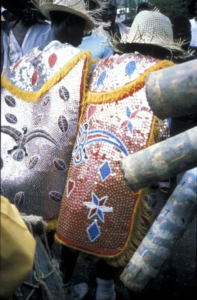 Rara celebrations are held during the Lenten season, starting right after the national Carnival every Thursday, Saturday and Sunday all the way up to the Monday after Easter. Rara processions are best during holy week, while Catholics are silently meditating on the crucifixion of Jesus Christ. It is said that in The Black Code of 1685, Easter weekend was given to the African slaves as a time of rest. During this time, they donned the brightest colors, and celebrated with dance and drums.
Rara celebrations are held during the Lenten season, starting right after the national Carnival every Thursday, Saturday and Sunday all the way up to the Monday after Easter. Rara processions are best during holy week, while Catholics are silently meditating on the crucifixion of Jesus Christ. It is said that in The Black Code of 1685, Easter weekend was given to the African slaves as a time of rest. During this time, they donned the brightest colors, and celebrated with dance and drums.
During holy week, the groups perform some spiritual rituals which became necessary when the angels and saints disappeared into the underworld on Good Friday. The groups hit the trail for three days straight. At the end of the third day, which is either Holy Saturday or Easter Sunday, they burn a stuffed doll which symbolizes Jesus being crucified.
Every rara group has a lakou, the stronghold of Vodou, for the lwa, protectors, that they serve in a small ceremony before the group heads out. These lakou are overseen by a patriarch, ougan (Vodou priest) or Papa lwa. It is rare for the lakou to be headed by a manbo (Vodou priestess). Hounsi, the newly initiated and faithful members, and the Ougan or mambo, together form the group of chantrel (folklore musicians), samba (composers), and simido (singers).
The ceremonies, popular religious music, “pran lwa” (entering a trance), and sermons at the crossroads prove that the usage of wine and other symbolic elements are essential feature of Rara. All these details in the processions are very important: the artistic, cultural, historical, religious and social aspects..
The periods of high activity in Rara are important moments for the initiation, moments of magic exhibitions and ceremonies for Vodou practitioners. The main ceremonies are Kouche Jon, Flanbe, and Kase Fey.
Kouche Jon: Baptism to annoint the “staff” and make it perform better. The rod is set down in a sacred place, with sermons, in front of the Baron for 2 or 3 days before Good Friday.
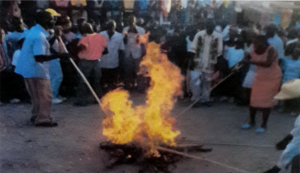 Flanbe: Ritual where a fire is lit at a crossroad with alcohol and a pile of wood. This is done to call upon the Lwa of the Lakou and ask for their support and protection during the course.
Flanbe: Ritual where a fire is lit at a crossroad with alcohol and a pile of wood. This is done to call upon the Lwa of the Lakou and ask for their support and protection during the course.
Kase Fey: This is a holy bath prepared with leaves, organized for the boys and girl of the lakou and other participants to protect them against any evil spells that may be used against them during the course, and give them luck during the rest of the year.
Any object used, such as whistles, whips, staves, musical instruments, etc, must undergo a special ceremony before they are used. During the course, the groups perform rituals and incantations, pran lwa (or people in the area or members of the lakou), and these happen at specific places along the route that are considered special, such as crossroads, big trees, water fountains etc.
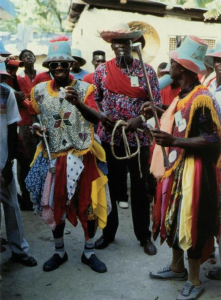 Majò Jon are the stars of the Rara groups, and each group can have from two to six Majon Jon. He is dressed in an original costume (brightly colored shirt with glitter, a paper bag hat, a red, green, or yellow coat with fringes), with makeup on his face, and a whistle in his mouth. The Majò Jon are good at holding a wooden staff, called the Jon, balanced perfectly which he twirls while performing a dance called “Chayopye”. The Majò Jon is responsible for order and discipline in the group, and monitors and repels the wanga (or evil spells) that might be left for them on the road or at crossroads. It must be noted that spirits are made to enter the instruments, and the Majo Jon himself, so that he can be able to perform these acts. The Majo Jon say is said to always be possessed by spirits.
Majò Jon are the stars of the Rara groups, and each group can have from two to six Majon Jon. He is dressed in an original costume (brightly colored shirt with glitter, a paper bag hat, a red, green, or yellow coat with fringes), with makeup on his face, and a whistle in his mouth. The Majò Jon are good at holding a wooden staff, called the Jon, balanced perfectly which he twirls while performing a dance called “Chayopye”. The Majò Jon is responsible for order and discipline in the group, and monitors and repels the wanga (or evil spells) that might be left for them on the road or at crossroads. It must be noted that spirits are made to enter the instruments, and the Majo Jon himself, so that he can be able to perform these acts. The Majo Jon say is said to always be possessed by spirits.
REFERENCES
Bibliothèque du Bureau National de l’Ethnologie
Faculté d’Ethnologie
Bibliothèque de la Faculté des Sciences Humaines
Konpè Filo
Claude Carré
Errol Josué
Rachelle Beauvoir Dominique
Bibliographiques
Junior Bigaud (2011) - Mémoire présentée pour Licence en sociologie
Université d’Etat d’Haïti - Faculté des Sciences Humaines
Département de Sociologie
Emmanuel C. Paul (1962) – Panorama du folklore haïtien
Gerson Alexis (1970) – Lecture en anthropologie de l’haïtien
-
B. Romain (1978) – L’africanisme haïtien
Claude Carré (2004) – Approche comparative entre les musiques coutumières et musiques folkloriques
Elizabeth McCallister (200) - Elizabeth McCallister Rara (2002) - Vodou, Power and Performance in Haiti and its Diaspora

